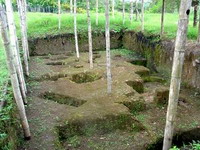Pennsylvania university museum to exhibit Panamanian treasures
People can admire gold artifacts and other ancient treasures thanks to a fickle river in central Panama.

When the Rio Grande de Cocle changed course in the early 1900s, a tantalizing cache of golden beads and pottery pieces washed upon its banks. Mysterious accounts of a river flowing with gold enticed a University of Pennsylvania Museum of Archaeology and Anthropology excavation team to the site in 1940.
There, they uncovered the cemetery of a thriving pre-Columbian settlement previously unknown to historians and dating from approximately 700 A.D. to 900 A.D. About 150 of the most important artifacts they excavated are on display at the museum's "River of Gold" exhibit opening Sunday.
"There have been a lot of excavations in Panama since then," said Pamela Jardine, curator of the exhibit. "But no one has ever come up with another of these large graves."
Archaeologists from Harvard University's Peabody Museum first visited the site in Sitio Conte, Panama, about 100 miles (160 kilometers) west of Panama City, in the 1930s. The Conte family, who owned the land, invited Harvard and Penn archaeologists to the site after realizing the significance of the treasures the shifting river was pushing to the surface.
Buried on and around the three-tier grave site's 1,000-year-old skeletons were gold pendants, bracelets, beads and small chest plates. The level of artistry and technical prowess astonished the archaeologists, Jardine said.
Most of the artifacts discovered during the Penn Museum's 1940 excavation feature motifs of animals or animal-human hybrids that likely served as family insignia or battle emblems.
Archaeologists, short on money and pressed for time with the rainy season approaching, unearthed thousands of items in just three months.
Chest plates and arm cuffs - worn in battle and at burial - were created from hammered gold sheet. Some employed the repousse metalworking technique, in which a relief design is created on the front of a piece by hammering on the reverse side.
Pendants, bangles and other pieces feature finely detailed faces and ornamentation made by the lost-wax casting method - a complex process still in use today - of gold/copper alloy with precious and semiprecious stones, animal teeth and bones, and ivory.
"They're not artists just starting out; they were very sophisticated," Jardine said. "Looking at the pieces, I also like to think that they were having fun with what they were doing."
The burial site, remarkably undiscovered by Spanish conquistadors who effectively decimated the native population in the 16th century, contained 23 skeletons wearing and surrounded by mortuary objects that allowed researchers to determine their social status. The commoners were buried with less gold than the high chief and others of the elite class - including his wife and the warriors he led in battle.
"Think about gold: It's got amazing strength, it doesn't tarnish, the way it shines in the sun," Jardine said. "It made them almost supernatural."
After its Philadelphia run ends Dec. 16, "River of Gold" departs for a two-year tour to Hilliard University Art Museum in Lafayette, Louisiana; The Museum of Fine Arts in Houston; Frank H. McClung Museum in Knoxville, Tennessee; Joslyn Art Museum in Omaha, Nebraska; and Dennos Museum Center in Traverse City, Michigan.
Subscribe to Pravda.Ru Telegram channel, Facebook, RSS!




